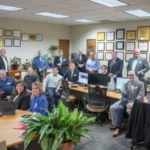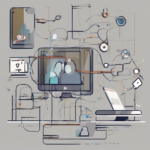SaaS and CRM: A Powerful Partnership for Business Growth
In today’s rapidly evolving business landscape, companies are constantly seeking innovative ways to streamline operations, enhance customer experiences, and drive growth. Two key technologies that have emerged as essential tools for achieving these goals are Software-as-a-Service (SaaS) and Customer Relationship Management (CRM).
What is SaaS?
SaaS, or Software-as-a-Service, is a cloud-based software delivery model where applications are hosted by a third-party provider and made accessible to users over the internet. Instead of installing and maintaining software on local servers, users simply subscribe to the service and access it through a web browser or mobile app.
- Benefits of SaaS:
- Scalability: Easily adjust resource allocation based on changing business needs.
- Cost-effectiveness: Pay-as-you-go model eliminates upfront capital expenditure.
- Accessibility: Access applications from anywhere with an internet connection.
- Automatic updates: Software is constantly updated and maintained by the provider.
- Reduced IT overhead: Eliminates the need for in-house IT infrastructure and support.
What is CRM?
CRM, or Customer Relationship Management, is a strategy and technology for managing and improving interactions with customers. CRM systems provide a centralized platform for storing customer data, tracking interactions, automating processes, and analyzing customer behavior.
- Key Features of CRM:
- Contact management: Store and organize customer information, including contact details, demographics, and communication history.
- Sales automation: Streamline sales processes, track opportunities, and manage pipelines.
- Marketing automation: Segment customers, create personalized campaigns, and track results.
- Customer service management: Handle customer inquiries, resolve issues, and track customer satisfaction.
- Analytics and reporting: Gain insights into customer behavior, identify trends, and make data-driven decisions.
The Intersection of SaaS and CRM
The combination of SaaS and CRM offers a powerful solution for businesses looking to enhance their customer interactions and drive growth. By leveraging cloud-based CRM solutions, organizations can enjoy the benefits of both technologies, resulting in a comprehensive and flexible system for managing customer relationships.
- Advantages of SaaS-based CRM:
- Scalability: Easily adapt to changing customer volumes and business needs.
- Cost-effectiveness: Avoid large upfront investments and pay only for the features you use.
- Accessibility: Access CRM data and functionalities from anywhere with an internet connection.
- Integration: Seamlessly integrate with other SaaS applications, such as marketing automation and analytics tools.
- Agility: Quickly adapt to changing market conditions and customer preferences.
Benefits of Using SaaS and CRM Together
The synergy between SaaS and CRM provides a comprehensive suite of tools for optimizing customer interactions and driving business success.
Enhanced Customer Experience
- Personalized communication: Leverage customer data to deliver targeted and relevant messages.
- Improved customer service: Provide faster and more efficient support through automated workflows and knowledge bases.
- Proactive engagement: Identify customer needs and proactively address potential issues.
Increased Sales and Revenue
- Streamlined sales processes: Automate tasks and improve efficiency, leading to faster sales cycles.
- Data-driven decision-making: Use insights from customer data to make informed sales strategies.
- Improved lead generation: Target the right prospects and nurture them through the sales funnel.
Improved Operational Efficiency
- Centralized data management: Store and access all customer information in a single platform.
- Automated workflows: Automate repetitive tasks, freeing up time for more strategic activities.
- Reduced manual errors: Minimize human error by automating processes.
Choosing the Right SaaS CRM Solution
With a wide range of SaaS CRM solutions available, it’s crucial to select one that aligns with your specific business needs and goals. Consider the following factors:
- Industry-specific features: Look for solutions that cater to the unique requirements of your industry.
- Scalability: Choose a platform that can grow with your business and handle increasing data volumes.
- Integration capabilities: Ensure seamless integration with other business applications.
- User-friendliness: Opt for a solution with an intuitive interface and ease of use.
- Customer support: Evaluate the provider’s level of customer support and responsiveness.
Case Studies: Success Stories of SaaS CRM Implementation
Numerous organizations have successfully implemented SaaS CRM solutions, resulting in significant improvements in customer engagement, operational efficiency, and revenue growth.
- Example 1: [Company name] used a SaaS CRM to streamline its sales processes, resulting in a 20% increase in sales conversions.
- Example 2: [Company name] implemented a SaaS CRM to improve customer service, leading to a 15% increase in customer satisfaction ratings.
Conclusion
SaaS and CRM have become indispensable tools for businesses looking to thrive in today’s competitive market. By leveraging the power of these technologies, organizations can enhance customer experiences, drive revenue growth, and achieve operational excellence. As technology continues to evolve, the integration of SaaS and CRM will become even more essential for businesses of all sizes to succeed.








